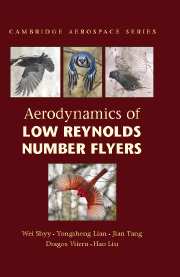1 - Introduction
Published online by Cambridge University Press: 05 July 2009
Summary
Bird, bat, and insect flight has fascinated humans for many centuries. As enthusiastically observed by Dial (1994), most species of animals fly. There are nearly a million species of flying insects, and of the living 13,000 warm-blooded vertebrate species (i.e., birds and mammals), 10,000 (9000 birds and 1000 bats) have taken to the skies. With respect to maneuvering a body efficiently through space, birds represent one of nature's finest locomotion experiments. Although aeronautical technology has advanced rapidly over the past 100 years, nature's flying machines, which have evolved over 150 million years, are still impressive. Considering that humans move at top speeds of 3–4 body lengths per second, a race horse runs approximately 7 body lengths per second, a cheetah accomplishes 18 body lengths per second (Norberg, 1990), a supersonic aircraft such as the SR-71, “Blackbird,” traveling near Mach 3 (~2000 mph) covers about 32 body lengths per second, it is amazing that a common pigeon (Columba livia) frequently attains speeds of 50 mph, which converts to 75 body lengths per second. A European starling (Sturnus vulgaris) is capable of flying at 120 body lengths per second, and various species of swifts are even more impressive, over 140 body lengths per second. The roll rate of highly aerobatic aircraft (e.g., the A-4 Skyhawk) is approximately 720°/s, and a Barn Swallow (Hirundo rustics) has a roll rate in excess of 5000°/s. The maximum positive G-forces permitted in most general aviation aircraft is 4–5 G and select military aircraft withstand 8–10 G.
- Type
- Chapter
- Information
- Aerodynamics of Low Reynolds Number Flyers , pp. 1 - 27Publisher: Cambridge University PressPrint publication year: 2007
- 10
- Cited by



